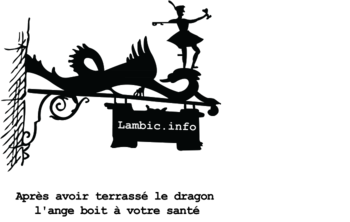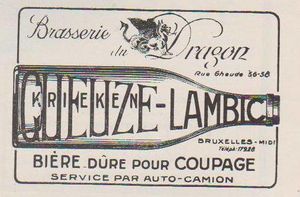Lambic.Info Logo: Difference between revisions
No edit summary |
No edit summary |
||
| Line 1: | Line 1: | ||
[[Home|← Home]] <br> | [[Home|← Home]] <br> | ||
Below the Lambic.Info logo a saying in French reads ''« Après avoir terrassé le dragon, l’ange boit à votre santé. »'' Loosely translated to English it means ''“After slaying the dragon, the angel toasts to your health.”'' The saying and original illustration come from the very last page of an important work of early lambic literature titled [[Books#Les_Memoirs_de_Jef_Lambic|Les Memoirs de Jef Lambic”]] written by Jef Lambic, who was the son of a lambic brewer at Brouwerij De Keersmaeker and illustrated by Robert Desart, a Belgian folkloric artist. No other explanation was given except for the phrase and the original image, and it immediately jumped out at us. We decided to dig deeper into the origin of the image and the meaning behind the phrase.[[File:LambicInfoDragon.png|right|350px]] | Below the [https://www.lambic.info Lambic.Info] logo a saying in French reads ''« Après avoir terrassé le dragon, l’ange boit à votre santé. »'' Loosely translated to English it means ''“After slaying the dragon, the angel toasts to your health.”'' The saying and original illustration come from the very last page of an important work of early lambic literature titled [[Books#Les_Memoirs_de_Jef_Lambic|Les Memoirs de Jef Lambic”]] written by Jef Lambic, who was the son of a lambic brewer at Brouwerij De Keersmaeker and illustrated by Robert Desart, a Belgian folkloric artist. No other explanation was given except for the phrase and the original image, and it immediately jumped out at us. We decided to dig deeper into the origin of the image and the meaning behind the phrase.[[File:LambicInfoDragon.png|right|350px]] | ||
<br> | <br> | ||
__TOC__ | __TOC__ | ||
Revision as of 18:10, 28 January 2015
Below the Lambic.Info logo a saying in French reads « Après avoir terrassé le dragon, l’ange boit à votre santé. » Loosely translated to English it means “After slaying the dragon, the angel toasts to your health.” The saying and original illustration come from the very last page of an important work of early lambic literature titled Les Memoirs de Jef Lambic” written by Jef Lambic, who was the son of a lambic brewer at Brouwerij De Keersmaeker and illustrated by Robert Desart, a Belgian folkloric artist. No other explanation was given except for the phrase and the original image, and it immediately jumped out at us. We decided to dig deeper into the origin of the image and the meaning behind the phrase.

The Legend of Saint George

What do angels, dragons, and beer have in common and how did that phrase come to be on the last page of a book about Brussels lambic culture in the late 19th century? To find that answer we must go back to the episode of Saint George and the Dragon. This legend, brought back by Crusaders returning from battle, is a traditional romantic heroic tale dating to as early as the 10th century AD, though possibly earlier. Several other similar versions of this story exist from all across Europe, and it was appropriated by various cultures and groups.
The legend tells of a fictional town whose lake was home to a dragon that would spread a plague among the villagers unless he was appeased. In order to appease this dragon the townspeople fed it two sheep a day in hope that the dragon would leave them alone. When this did not work, they resorted to feeding the dragon children whose names were drawn by lottery. When the king’s daughter’s name was drawn he offered all of the gold and silver in the kingdom for her life to be spared, yet the townspeople refused. The princess, dressed as a bride, arrived at the lake ready to be fed to the dragon.
At the same time, Saint George was riding past the lake and noticed the princess and refused to leave her side. As the dragon came to eat her, George made the sign of the cross, charged the dragon on his horse, and speared him with his lance. He then returned to the town with the princess and the dragon following behind her on a leash. Shocking the townspeople with the dragon, he implored them to all convert to Christianity and be baptized. If they did this, he would slay the dragon once and for all. The townspeople agreed, the dragon was killed, and a new church was erected on the spot were the dragon was slew in honor of the Virgin Mary and Saint George.
Acta Sanctorum and Jean Bolland
Though the hagiography of Saint George had been well established for centuries and his legends firmly entrenched in European and other cultures, the end of the Renaissance period n Europe saw a renewed interest in the serious study of Christian Saints and their acts and an effort to expel many of the medieval myths surrounding them. This included a detailed analysis of the acts of Saint George by Jean Bolland.[1] Bolland was among a group of Jesuit scholars who worked on and published the Acta Sanctorum (Acts of Saints) in a series of volumes between 1643 and 1794. Bolland was born in 1596 in the village of Julémont, near the city of Liège in Belgium who identified as Flemish and undoubtedly had experience with the beers made famous in Brueghel’s paintings
Saint George, The Dragon, and Beer
Though the Bollandists sought to dispel many of the legends and rumors that surrounded the various saints of Europe, the legend of Saint George had become part of the cultural and religious lore of Belgium in general, just as it had across many parts of Europe. UNESCO recognizes celebrations dating back to the 14th century in the Belgian city of Mons in Saint George’s name as an event of Intangible Cultural Heritage and Humanity. [2] With these celebrations also came the traditional feasts and drinking. As we have discussed the cultural history of lambic elsewhere, it is safe to say that as the legend of Saint George became part of the traditional story telling culture of Belgium at the time, so too did the notion of the Saint slaying the dragon and returning to drink to his success and to the prosperity of the town and its people. In Belgian terms, this means that over time the traditional drink would have been lambic. The theme of the hero returning to celebrate the slaying of a monster is not uncommon in early literature and persisted in many of the folkloric tales of early modern Europe.

Saint George is the patron saint of many places and of many things, and he is often found in reference to beer and brewing. Many breweries are either named for him or have beers alluding to him and his feats. According to Frank Boon of Brouwerij Boon, Saint George is even the patron saint of lambic brewers[3], though other sources note that it is actually Saint Veronus who is the patron saint of lambic brewers and also the town of Lembeek. This statement does have some factual backing. The Saint Veronus Church in the town does have dragon motifs, and these are atypical for the period and region in general. Many have also seen references to Cantillon’s Bière du Dragon. Though little is known about the actual beer, logos on coasters and breweriana show a pronounced dragon. At one point, there was also a “Brasserie du Dragon” whose address was the same as Cantillon’s today (56 rue Gheude B-1070 Brussels) and who listed Gueuze-Lambic and Krieken as their products. Research is still ongoing as to the origins of that name and brewery.
Original Signage
The legend of Saint George and its apparent connection to Belgium, the town of Lembeek, beer, and lambic in general is apparent after some research. What is still unknown is where the inspiration for the original drawing of the sign by Robert Desart in the back of Les Memoris de Jef Lambic and the saying came from. It may be nothing more than a picture made up by the Desart ca.1955 as he was illustrating the book, but it may also be a sign that is still hanging above the door of an estaminet or café in an undiscovered corner of Brussels. Our hope is to someday find the original and uncover more of its history. The idea to adapt this logo for the project comes both out of respect for the cultural history of lambic and from the continued research that it represents.
References
- ↑ Christopher Walter - The Warrior Saints in Byzantine Art and Tradition, 2003
- ↑ UNESCO – Processional giants and dragons in Belgium and France
- ↑ Lambic Digest, May 12, 1994 – Mariage Parfait and the Procession of St. Veronus